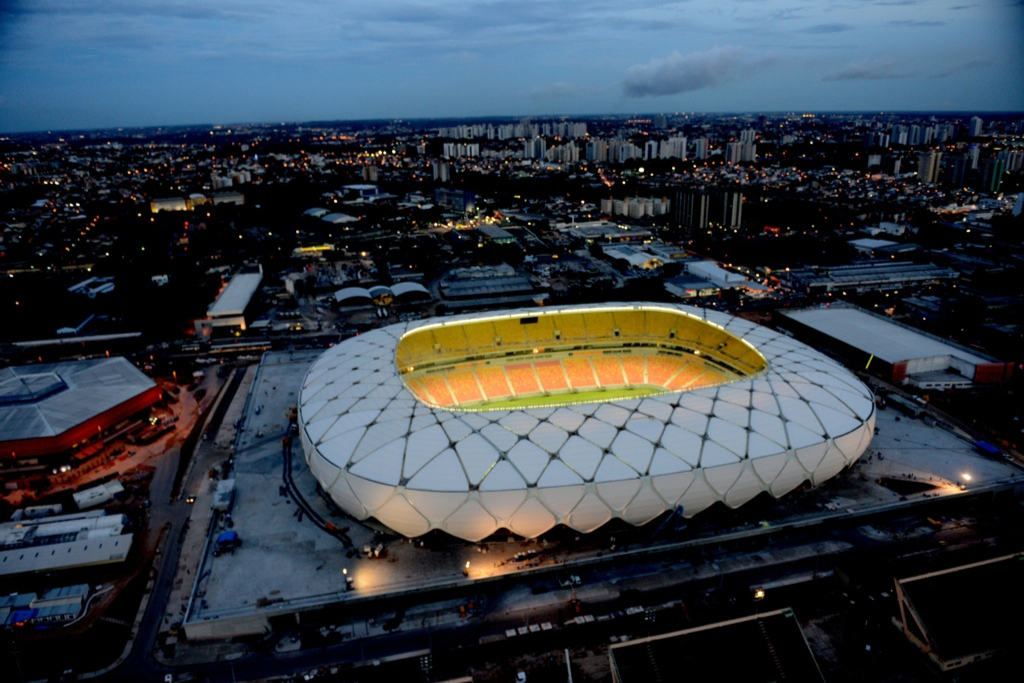Next up for the U.S. World Cup team is a key group stage game against Portugal. The setting for the game is the most talked about, controversial stadium of World Cup 2014: Arena Amazonia.
One of the six new stadiums built expressly for the World Cup, the 45,000-seat Amazonia is located in Manaus, a city of almost two million in the middle of the largest rainforest on the planet, with over two million square miles of jungle. The city is at the confluence of the Solomoes and Negro rivers, the place where the Amazon River begins.
The stadium has been widely praised for its aesthetics – designed by German firm Gerkan, Marg and Partners, designer of two other Brazilian World Cup stadiums (Belo Horizonte, Brasilia) and overseers of the recent renovation of Santiago Berenabeu in Madrid.
The inspiration for the stadium is a wicker basket filled with fruit, a nod to a major local craft and natural resource. Beyond the noteworthy, basket-like exterior, color is the main attraction on the inside. The seats have been painted like “fruit from the country, represented in seven colors (melon, banana, pineapple, orange, mango, guava and papaya),” according to Miguel Capobiango Neto, coordinator of the World Cup Project Management Unit. “The colours in here are very interesting, they add a joy inherent to all types of functions….”
Built at a final cost approaching $300 million, the stadium has been a lightning rod for criticism and concern in the run up to the World Cup.
Perhaps the major gamble of the planning for Brazil was to expand the number of stadiums for World Cup play from the FIFA required eight, to twelve, in an effort to spread the development and tourist generated economic benefits of the event to various regions. But because of it’s geographically remote location, climate, and questions regarding its long term use, Arena Amazonia has been symbolic of the problematic aspects of the Brazilian competition.
The logistical challenges were significant building a stadium in an area with limited transportation. Materials were shipped from Portugal, taking approximately three weeks for four ships containing steel, as well as the exterior design elements, to cross the Atlantic and navigate the Amazon. The project was so slow moving that, late last year, FIFA threatened to abandon the stadium, which prompted the final push to finish.
Another major concern, one also associated with the 2022 World Cup in Qatar, is the weather. Manaus is known for rain, high temperatures and high humidity (this year’s first group stage match between England and Italy was played at 86 degrees, with 61% humidity), a challenge for both players and pitch. Serious concerns preceded the world cup, as the turf has been spotty, despite the advanced technology employed (recycled rainwater, vacuum drainage). Even the paint on the seats had to be specially designed – according to Capobiano Neto, “if we don’t use the right kind of material then the sun will melt the paint away. The seats will just turn white.”
Perhaps most controversial is the stadium’s projected post-World Cup usage, an issue that still remains unclear. No team in the region can fill the stadium near to capacity, leading some to even propose that the facility could be converted to a prison, or other non-sporting uses. Local officials, however, hope that the World Cup will drum up both more soccer fans and more tourists and events.
The US team will find a visually interesting, iconic new stadium, but also intense heat and humidity, as they attempt to beat Portugal – it will truly be an Amazon adventure.

